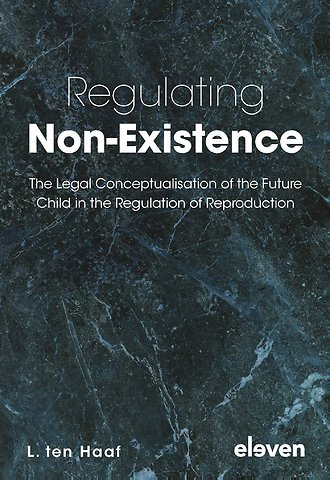Regulating Non-Existence
The Legal Conceptualisation of the Future Child in the Regulation of Reproduction
Samenvatting
Advances in reproductive biotechnology increase control over who is born and under what circumstances. Consequently, the question arises: what do we owe to the future children who are born with the help of these technologies? To address this question, we must understand how we should approach the future child. This conceptualisation is complicated by two factors: first, the future, unconceived child only exists as a legal construct. Second, protecting its interests often implies that the child itself is prevented from coming into existence.
This book explores the current conceptualisation of the future child in three legal systems. It assesses whether speaking of the ‘interests of the future child’ is a tenable approach to this unique entity. By doing so, it explores various themes, such as human dignity, the non-identity problem, legal personhood and interests. In addition, the book elaborates on an alternative approach to understanding the future child.
Regulating Non-Existence offers an important contribution to ongoing discussions in the field of legal theory, biolaw and bioethics. This book is relevant for scholars and decision-makers grappling with the question of what we owe to the future child in the context of reproductive issues.
Trefwoorden
Specificaties
Inhoudsopgave
1.1 Preventing Existence: Then and Now 1
1.2 The Complexity of the Future Child 11
1.2.1 The Unborn Child 11
1.2.2 Future Generations 14
1.2.3 The Future Child 15
1.3 Aim and Research Questions 20
1.4 Method and Scope 20
1.4.1 Method: Constructivism, Fit, and Justification 20
1.4.2 Scope: Reproductive Technologies 24
1.5 Outline 29
2 The Interests of the Future Child in the Regulations on Reproduction 33
2.1 Introduction 33
2.1.1 Selection of Legal Systems 35
2.1.2 Regulations on Reproduction 43
2.2 The Interest to be free from Harm 45
2.2.1 The Regulations 45
2.2.2 Discussion 56
2.3 The Interest in forming an Identity 63
2.3.1 The Regulations 63
2.3.2 Discussion 72
2.4 The Interest in Respect for Human Dignity 74
2.4.1 The Regulations 74
2.4.2 Discussion 83
2.5 Conclusion 93
3 Harm, Identity and Dignity 97
3.1 Introduction 97
3.2 The Concept of Harm 98
3.3 The Concept of Identity 101
3.3.1 Identity and Harm 101
3.3.2 Narrative Identity 103
3.3.3 Genetic Resemblance or Origin Story 108
3.4 The Concept of Human Dignity 110
3.4.1 Dignity and Harm 110
3.4.2 Two Interpretations of Dignity 115
3.5 Conclusion: the Individual and Collective Dimensions of the Human Person 123
4 An Interest in Non-Existence 127
4.1 Introduction 127
4.2 The Non-Identity Problem 131
4.3 Abandoning the Harm Principle 134
4.3.1 A Non-person Affecting Principle 134
4.3.2 Limited to Same Number Choices 137
4.3.3 Choosing the Best Child 139
4.4 Better Off Not Existing 143
4.4.1 Comparison with Non-existence 145
4.4.2 Harmed by Existence: the Zero Line 147
4.4.3 Reasonable Well-being 149
4.5 Conclusion: Wrongful Life in the Regulations on reproduction 151
5 The Future Child as a Legal Person 157
5.1 Introduction 157
5.2 The Naturalist Approach to Legal Personality 160
5.3 The Constructivist Approach to Legal Personality 164
5.4 Legal Personality as an Anticipation 167
5.4.1 The Nasciturus Fiction 168
5.4.2 The Personhood Dependent Principle 172
5.5 Conclusion: Representation of the Non-existent 175
6 The Future Child as the Subject of Legal Interests 177
6.1 Introduction 177
6.2 The Subject of Interests 179
6.3 The Capacity to have Interests 187
6.3.1 Interests and Existence 189
6.3.2 Actual and Potential 193
6.4 Conclusion: the Paradox of the Interests of the Future Child 196
7 The Future Child as the Object of our Responsibility 199
7.1 Introduction 199
7.2 Jonas’s Theory of Responsibility 205
7.2.1 The Concept of Responsibility 206
7.2.2 The Object of our Responsibility: The Idea of Man 211
7.3 Responsibility for the Future Child 218
7.3.1 The Conceptual Framework: the Collective and the Individual 219
7.3.2 The Normative Framework: the Notion of the Human in the Regulation of Reproduction 224
7.4 Conclusion 242
8 Conclusion – Regulating Non-Existence 245
8.1 The Interests of the Future Child 245
8.2 The Four Assumptions of the Interests-Construction 246
8.3 Responsibility for the Future 249
8.4 The Future of Responsibility 254
Summary 261
Bibliography 275
Glossary and list of abbreviations 291
Index 295
Anderen die dit e-book kochten, kochten ook
Net verschenen
Rubrieken
- aanbestedingsrecht
- aansprakelijkheids- en verzekeringsrecht
- accountancy
- algemeen juridisch
- arbeidsrecht
- bank- en effectenrecht
- bestuursrecht
- bouwrecht
- burgerlijk recht en procesrecht
- europees-internationaal recht
- fiscaal recht
- gezondheidsrecht
- insolventierecht
- intellectuele eigendom en ict-recht
- management
- mens en maatschappij
- milieu- en omgevingsrecht
- notarieel recht
- ondernemingsrecht
- pensioenrecht
- personen- en familierecht
- sociale zekerheidsrecht
- staatsrecht
- strafrecht en criminologie
- vastgoed- en huurrecht
- vreemdelingenrecht







